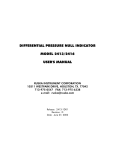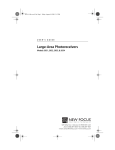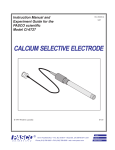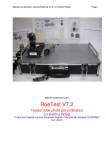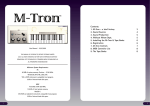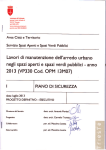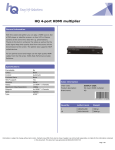Download Solar Sudden Ionospheric Disturbance Monitor
Transcript
Solar Sudden Ionospheric Disturbance Monitor Technical Manual Authors: Ray Mitchell, Chief Engineer Bill Clark, Senior Circuit Design Lead Document Status: PRELIMINARY Draft Version 1.0 02-Aug-2006 1 Table of Contents: SIDMON Chassis Controls, Status, and Connections ....................................................................... 3 Introduction To The SIDMON Circuit Board ................................................................................... 4 Circuit Overview..................................................................................................... 4 Power Supply .......................................................................................................... 5 Preamp Circuit ........................................................................................................ 6 Frequency Board..................................................................................................... 7 Frequency Board Tuning Resistor Table ................................................................ 8 SIDMON & Frequency Board Connectors............................................................. 8 How to tune a Frequency Board ............................................................................. 9 Post-amp Circuit ................................................................................................... 11 Amplitude Modulation Detection Circuit ............................................................. 12 Audio Output ........................................................................................................ 13 Appendix A: Component Placement ............................................................................................... 15 Appendix B: SIDMON PCB Artwork ............................................................................................. 16 Appendix C: FREQBOARD PCB Artwork..................................................................................... 17 Appendix D Test Points Glossary.................................................................................................... 18 Appendix E: Parts List ..................................................................................................................... 19 Appendix F: Schematics .................................................................................................................. 20 +5/-5 Volt Power Supply ...................................................................................... 20 Pre/Post Amplifiers............................................................................................... 21 Audio and Analog Data Outputs........................................................................... 22 Frequency Tuning Board ...................................................................................... 23 Table of figures: Figure 1: SIDMON Front Panel......................................................................................................... 3 Figure 2: SIDMON Rear Panel.......................................................................................................... 3 Figure 3: SIDMON Circuit Board ..................................................................................................... 4 Figure 4: Power Supply ..................................................................................................................... 5 Figure 5: Preamp................................................................................................................................ 6 Figure 6: Filter Circuit ....................................................................................................................... 7 Figure 7: Power Supply Filter Caps................................................................................................... 7 Figure 8: Connections on SIDMON and Frequency boards.............................................................. 8 Figure 9: Test Fixture (left: Schematic, right: the homemade attenuator circuit) ............................. 9 Figure 10: Example of Tuning a SIDMON ..................................................................................... 10 Figure 11: Post-Gain Amp ............................................................................................................... 11 Figure 12: Amplitude Modulation Detection Circuit....................................................................... 12 Figure 13: Audio Output.................................................................................................................. 13 Figure 14: DATAQ Output Circuit.................................................................................................. 14 Figure 15: DATAQ Output Calibration Notes................................................................................. 14 Figure 16: SIDMON Component Placement................................................................................... 15 Figure 17: FREQBOARD Component Placement .......................................................................... 15 Figure 18: SIDMON PCB Top Layer.............................................................................................. 16 Figure 19: SIDMON PCB Bottom Layer ........................................................................................ 16 Figure 20: FREQBOARD PCB Top Layer ..................................................................................... 17 Figure 21: FREQBOARD PCB Bottom Layer................................................................................ 17 Figure 22: +5/-5 Volt Power Supply................................................................................................ 20 Figure 23: Pre/Post Amplifier.......................................................................................................... 21 Figure 24: Audio and Analog Data Outputs .................................................................................... 22 Figure 25: Frequency Tuning Board................................................................................................ 23 2 SIDMON Chassis Controls, Status, and Connections 1 2 3 4 5 Figure 1: SIDMON Front Panel Number Connectors / Status / Controls 1 AUDIO (Powered Speakers) 2 3 4 5 X1 X5 X10 RF GAIN ADJUST ANTENNA INPUT POWER ON 6 Parameters 1/8” stereo jack Line-in/out level Post Gain Switch (3 pos) Preamp (200KΩ R3) TNC Connector Power Status: Green LED = +5v Yellow LED = -5v 7 Details (See Circuit) Audio Output Post Amp Circuit Preamp Circuit Preamp Circuit Power Supply 8 Figure 2: SIDMON Rear Panel Number Connectors / Status / Controls 6 POWER INPUT 7 Serial Number Area 8 DATA OUTPUT Parameters Mates w/ 2.1 mm x 5.5 mm plug 9 ~ 10 VAC input voltage Top line: Serial number S-#### Middle: Serial Number FB-#### Bottom: Frequency / Station ID Mates w/ Phoenix connector part# 803578, 3.81 2P PLUG 180DEG Details (See Circuit) Power Supply N/A DATAQ Output Circuit Chassis Dimensions: 5.25” (13.34 cm) L x 3.63” (9.22 cm) W x 1.825” (4.636 cm) 3 Introduction To The SIDMON Circuit Board This document describes the circuit design and theory of operation of the SID Monitor circuit; for instructions how to calibrate and use the SID monitor please refer to the user’s manual. 2 5 3 7 4 6 8 1 Figure 3: SIDMON Circuit Board 9 Circuit Overview Starting at the lower left of the SIDMON circuit board and working around the various signal processing stages or sections in numeric order: 1The Power Supply Section takes input from the 9-10 VAC from the transformer and produces both regulated positive and negative 5 volt supplies. 2 The TNC input feeds the broadband signal in from the antenna into the 3 Preamp Stage with the RF gain control. The signal is then routed into the 4 Frequency Board Filter Stage (called FREQBOARD). This section extracts the desired VLF transmitter station frequency as Amplitude Modulation (AM) from the broadband signal. The AM signal leaves the FREQBOARD and routed to the 5 Post-Amp Stage for a user-selectable signal boost the post-amp switch labeled x1, x5 and x10. 6 The signal is routed to the Signal Detect Stage that performs a full-wave rectification of the signal making the waveform all positive, i.e. the absolute value of all signal components. The detected signal is then routed to the 7 Audio Output Stage where the line-level audio signal is sent out the 1/8” audio output jack and monitored through power speakers. Also the detected signal from 6 is routed into the 8 Signal Strength Stage. An integrator (Resistor/Capacitor circuit) converts the detected AM signal into an average DC level, indicating overall signal strength. The DC level (analog output) exits the SID Monitor via 9 the 2-position Phoenix connector that is connected to the DATAQ module (ADC) that converts the analog level to digital values that are then transmitted via RS-232 to the computer and recorded by the software. 4 Power Supply Figure 4: Power Supply The input is a 2.5mm x 5.0mm jack that accepts the 9-10 volt AC wall transformer. The fuse (F1) is a re-settable 250mA circuit breaker. If there is a short circuit the fuse will open and remain open until the power is removed and the fuse cools down. The AC to DC voltage conversion is achieved by a half-wave rectifier (diodes D1 and D2) and smoothed by capacitors C1 and C2 (Higher frequencies bypassed by C5 and C6). The DC working voltage on these caps should be rated at two times the input voltage, plus we added 50% more as a precaution, therefore: WVDC = 2.5 x Vac (input voltage) = 25 VDC. The power supply is a typical design per recommendations from the manufacture’s application sheets; for the +5 volt supply IC1 (78L05) and –5 volt supply IC2 (79L05). We used the ‘L’ versions of the regulator for their characteristics of both lower dropout voltages and over current regulation properties. The diodes (D3, D4, D5, D6) prevent a reverse voltage situation that can result when the capacitors are charged up and power reapplied on the input. Caps C3, C4, C7, and C8 are part of the filtering and recommended design by the manufacturer. The two status-LED’s visible on the front panel show independently that both power supplies are functioning. The LED color assignments are as follows: +5V is green. –5V is yellow. Overall the current draw on the power supply is small, in the 100-200 milliamps range. It was necessary to design the power supply with lots of filtering in order to provide clean DC power to all of the RF filters and amplification stages. 5 Preamp Circuit Figure 5: Preamp Note: this circuit does not include any lightning suppressors; it is the responsibility of the user to install them. Another protection mechanism suggested by an engineer, but after the PC boards were made, was a signal-limiter clamp made from two signal diodes (1N914’s) back-to-back across the input of the first stage op amp. As of the writing of this manual, we have not seen any problems with overvoltage, and not added these components to the boards, however it is worth mentioning for consideration. The antenna input is inputted through a TNC connector. Capacitor C8 isolates DC voltage on the input as well as performing a high-pass filter RC function consisting of C8 (0.1 μF) and R4 (2.2KΩ) is a high-pass filter (about 723 Hz) to help reject 50/60 Hz power-line hum. fo = 1 / (2πRC) = 1 / (2π x 2.2KΩ x 0.1μF) = 1 / (2π x 2.2x103 x 0.1x10-6) ∴ fo = 723 Hz The R4 resistor could also serve as an AC impedance match to the antenna, however this value cannot be optimized due to the variability of antenna design and consequences to the fo frequency response of the high-pass filter thus it is better for the user to make up for the loss in the impedance match by increasing the RF gain. The first stage of the preamp (IC3:G1 TLE2082CP) is a non-inverted input with a gain of 201x. The output (DC decoupled) runs to the next stage, which is an inverted input, has a gain that has an adjustable potentiometer (R3) from 0 to 20x, giving a total gain from the preamp stage of 0 to 4,020x. The RF gain (R3) potentiometer adjustment will be made by the end-user and is covered in the user’s manual. IC3 G$1 Non-Inverted op amp gain formula (A = Amplification) A = (R5 + R6)/ R5 = (1KΩ + 200KΩ) / 1KΩ ∴ A = 201 (Fixed gain) IC3 G$2 Inverted op amp gain formula A = R3 / R7 = (0Ω to 200KΩ) / 10KΩ ∴ A = 0 to 20 (Adjustable gain) 6 Frequency Board Figure 6: Filter Circuit The Frequency board (called “Freqboard”) is tuned before shipping. The design is based on the MAX275 continuous analog filter configured as a bandpass filter. The filter tuning is based on four resistors per filter, and there are two filters. Resistors R100 – R104 are for the first filter and R200 – R204 are for the second filter (or stage) The Frequency board is a separate PCB to make it easier to change the SIDMON’s VLF frequency. It would be simple process to swap this board. When this board is changed, the SIDMON has to go through the same procedures of antenna alignment and qualification procedures (as outlined in the user’s manual) as if it were a new monitor. Figure 7: Power Supply Filter Caps Not much to say about this, pretty standard design principles used. The power supply bypass capacitors were installed per manufacturer’s specifications. The 4.7 μF for large DC fluctuations and 0.1 μF for smaller AC spikes. 7 Frequency Board Tuning Resistor Table With the components as outlined in the schematic it is possible only to tune a very narrow range of VLF stations: 24.0 NAA, 24.8 NLK, and 25.2 NML. Frequencies above or below this range are unreachable. To tune to other frequencies, you need to run the filter design software from MAXIM to determine the correct values for the resistors. Use 1% resistors. We used the Butterworth filter with 4 poles (requires 2 stages to implement the filter). Frequency Range R101 / R201 18.3 – 19.0 KHz* 24.0 – 25.2 KHz R102 / R202 Sets Center frequency R103 / R203 Sets Gain Sets Q R104 / R204 Sets Center Frequency 200.0 KΩ 200.0 KΩ 115.0 KΩ* ? 76.8 KΩ 549.0 KΩ 549.0 KΩ 90.9 KΩ* ? 75.0 KΩ *Resistor values untested – also: to do add more frequencies to this table. All resistors are 1% (or better). R100 and R200 are 10K Potentiometers in series with R102 and R202 respectively. Calculate resistors in the sequence given below: (Equations from MAXIM 274/275 Data Sheet) Formula Comments 9 R2 = R x02 + Rx00 = (2 * 10 ) / F0 Where F0 is the desired center frequency, this resistor is R2 in the MAXIM document, it is in series with Rx00 Rx04 = Rx02 – 5KΩ Rx04 might be less than 5KΩ because of internal 5KΩ resistor, limits BPO_ loading Rx03 = (Q * 109) / (5 * F0 ) Limits 5KΩ < Rx03 < 4MΩ 9 Rx01 = (2 * 10 ) / (5 *F0 * HOLP) HOLP is the gain of LPO_ at DC SIDMON & Frequency Board Connectors SIGNAL IN FREQ OUT SIDMON FREQBOARD Figure 8: Connections on SIDMON and Frequency boards Signal Description Neg. 5V GND Pos. 5V Signal Input Freq A (for tuning) Freq B (Frequency Out) Pin# SIDMON Side 1,3 4,5,8 7,9 2 6 (no connection) 10 8 Pin# FREQBOARD Side 2,4 3,6,7 8,10 1 5 9 How to tune a Frequency Board Tools / Supplies you’ll need: • Frequency generator • Oscilloscope • Frequency counter • Small screwdriver, preferably nonmetallic (contact with a metal screwdriver seems to affect the readings –keep this in mind while tuning) • BNC patch cords, oscilloscope probe, etc. • TNC male to BNC female adaptor / connector • Resistor / Attenuator test fixture 200 Ohm Signal Generator Input Output (To SIDMON) 1 ohm Figure 9: Test Fixture (left: Schematic, right: the homemade attenuator circuit) Step 1: Plug the FREQBOARD in the SIDMON and turn on the power. Step 2: Set the frequency generator output to the smallest output signal possible, then attenuate the signal further with a simple 2-resistor circuit See figure above. Step 3: Connect probe ground lead to a GND point on the SIDMON. (I usually like to connect the ground clip to the top of the TNC connector – see picture on next page.) Step 4: Use the oscilloscope probe connected to a frequency counter (or oscilloscope w/ a built-in counter) to probe the FREQBOARD at the test point labeled “input.” Adjust the RF gain control (R3) on the main SIDMON board to a voltage level of 100 millivolts peak-to-peak. Step 5: Verify the proper frequency is present. Adjust the frequency generator, and error of ±100 Hz is okay. Be sure to verify throughout the tuning process that the signal generator is on the desired frequency and hasn’t drifted off. I found for best results let the signal generator warm up and stabilize for a couple of hours before tuning the FREQBOARD. (Procedure continued on next page) 9 How to Tune a Frequency Board (Procedure continued from the previous page) Figure 10: Example of Tuning a SIDMON Step 6: Put the oscilloscope probe on the test point labeled “Freq A.” (As shown above) Additional comment: The picture above shows the finalized FREQBOARD, that is to say, the two pots are locked down with fingernail polish to finalize the settings and prevent further adjustment as per the instructions of the final step – leave the pots unpainted until that time. Step 7: Adjust R100 to achieve the peak signal response. A peak response is the highest possible response of the filter as seen on the oscilloscope. Watch the amplitude on the scope while turning the pot in either a clockwise or counter-clockwise direction; one of these directions will cause the signal amplitude to rise. At some point the amplitude crosses it maximum and begins to fall. Simply reverse the direction of the pot and the signal will again rise back up. Find the setting on the pot that gives the peak response to the input frequency. Step 8: Repeat step 7 for test point “Freq B” and adjust pot R200. It is normal to adjust the volts/division several times during this operation, as the gain will be around 4x per stage. If you hear a clicking sound coming from the pot while turning, then you have reached the end of travel of the pot, try reversing directions. If you traveled to either limit of the pot and still did not find the peak response, then the frequency you are attempting to tune is not possible with the current resistor values on the FREQBORD. Step 9: The SIDMON is now ready to test, or “burn-in,” we recommend a minimum of 24 hours to verify that the signal is being received and to discover any other electronic failures (such as caps plugged in backwards etc.). To burn-in the SIDMON follow the setup procedure in the User’s Manual, i.e. adjust the RF gain and pointing the antenna towards the transmitter, etc. Step 10: If the burn-in is successful, then finalize the pots R100 and R200 by painting them with some fingernail polish. Of course, if the burn-in process reveals a problem, e.g. no sunrise/sunset effect then repeat tuning procedure. One caveat to be aware of: sometimes the VLF stations go down for maintenance – it might not be the receiver’s fault. 10 Post-amp Circuit FREQ OUTÆ Æ TO Amplitude Modulation Detection Circuit Figure 11: Post-Gain Amp The post gain amplifier takes the “Frequency Out” signal, now separated from the broadband signal, and this stage amplifies it. The stage was included as a contingency because we were not sure if we needed another gain boost so this was to deal with unknown and variable conditions of a weak signal or poor antenna design. We decided to make this a selector switch instead of adding another potentiometers to avoid confusion. So far all monitors are using x1 with perhaps a few exceptions. I have found the x5 and x10 settings are good to boost the gain enough to make the input signal audible for antenna orientation. It is important to change this setting back to x1 for data logging. A = R17 / Rx ∴ A = 100KΩ / Rx ; where Rx is one of R14, R15, or R16 Switch Setting (Label on chassis) X1 X5 X10 Resistor Value Actual Gain (A) R14 R15 R16 49.9KΩ 20.0KΩ 4.7KΩ 2.004 5.000 21.277 The gain slide switch is a DP3T labeled on the chassis: x1, x5, and x10 note that the actual gains of the amplifier are different than labeled on the box –admittedly this appears to be dishonest. Initially the plan was to make them the same, but as the design went on it was decided to keep the labels on the box simple and make the make-up gains on the output look like 1x, 5x, and 10x instead of the internal circuits be consistent with their external labeling. (For those still curious: When the gains were set “as advertised” the resultant output voltages were not x1, x5, and x10 with respect to the switch setting.) This was an empirical design, and then we found out later that it wasn’t completely consistent with other frequency cards that have different gain characteristics. It is only an approximation… and in the end I have to say that this decision was done mainly for aesthetic appearances. 11 Amplitude Modulation Detection Circuit From Post Gain Æ Figure 12: Amplitude Modulation Detection Circuit This circuit is called an “Absolute-Value Circuit Full-Wave Precision Rectifier” taken from the “Op Amp Design Cookbook” Third Edition by Walter G. Jung pp236-237. We found the circuit would sometimes go into oscillation very easily, thus C17 (22 pF) was necessary to eliminate the oscillations. Test point “Signal Detect” is the full-wave, rectified signal that is sent to the audio buffer circuit. (See: Audio Output for more information) Test point “Signal Strength” is the integrated signal to produce the signal strength – this is a DC level. The RC circuit (R33 and C21) has an RC time constant is approximately between 5 and 9 seconds. (T = RC = 20KΩ x 470 μF = 20x103 x 470x10-6 ∴ T = 9.4 Seconds). This is approximate because capacitors have lower precision tolerances and we added a discharge resistor, R20, to provide a small load to discharge the capacitor (C21) in order to make the circuit respond to a lowering level faster than allowing its internal resistance to discharge the capacitor. The design of this filter was chosen carefully to reject short lived signal bursts, such as lightning, but allow longer persistent signal-strength changes such as those caused by solar flares, to affect the overall signal strength characteristics. Without this filter in place the resultant graph was too noisy to reliably detect solar flares, especially smaller class-C flares. Engineers would often ask me “why not filter in software?” and the answer is that we only sample once every 5 seconds, thus we would need to take more sample and run some sort of median or averaging algorithm to filter out the noise. This eliminates postprocessing and allows direct viewing of the data. However, engineers might be interested in experimenting with the RC values or even eliminating the RC circuit so that real-time monitoring of lightning and possible GRB (Gamma Ray Bursts) would be possible (it would also require to increase the cadence of the data logging, etc.) 12 Audio Output Figure 13: Audio Output IC4 G$2 is a unity-gain buffer, C14 isolates the DC component to the line-out level audio output to be connected to amplified speakers – do not connect directly to an 8 ohm speakers or headphones without an amplifier. The connector is a stereo connector with the left and right channels connected together. As of the writing of this document it is still unknown why plugging in the speaker would cause a dip in the signal strength level, perhaps there is some ground loop problem that has not been detected (both devices are powered by wall transformers). Whatever the cause, audio monitoring lowers the signal strength. 13 DATAQ Output Circuit Figure 14: DATAQ Output Circuit The LT1490 op amp allows voltages to swing from rail-to-rail. Stage 1 (IC6 G$1) has a gain of 33.127 (A = R8/ R10 = 267KΩ / 8.06KΩ ∴ A = 33.127). C12 and C13 dampen fluctuations and spikes. C16 stabilizes the voltage on the input to form a stable reference. Stage 2 (IC6 G$2) is a voltage shifter with a gain of 1. The shifter works because the (-) input is tied to +5 volts through R11, the inverter input makes the output to go to –5 Volts, the midpoint between R12 and R11 form a summing point therefore translates the input DC level to –5 volts to + 5 volts, a 10 volt range, thus making the overall signal easy enough for the DATAQ to read over it’s 20 volt / 10 bit range (approximately 0.0195 volts per bits). 2/3 1/3 Vnoon = -1.667 V Figure 15: DATAQ Output Calibration Notes The reason why user’s manual suggests setting the RF gain to –1.25 to –1.5 volts at noontime is because while developing the SIDMON we had to resolve the problem of determining how much headroom was required to record M- and X-class flares while not sacrificing resolution for the CFlares. The value of –1.5 volts was derrived by approximately using the first 1/3 of the graph to allow for noon – the highest point on the graph for daytime allowing the other 2/3 of the graph to be able to record the largest flares, and this level is usually still much higher than sunrise and sunset levels. Vnoon = 1/3 (10 volts absolute range) – 5volts = -1.667 Volts 14 Appendix A: Component Placement Figure 16: SIDMON Component Placement Figure 17: FREQBOARD Component Placement 15 Appendix B: SIDMON PCB Artwork Figure 18: SIDMON PCB Top Layer Figure 19: SIDMON PCB Bottom Layer 16 Appendix C: FREQBOARD PCB Artwork Figure 20: FREQBOARD PCB Top Layer Figure 21: FREQBOARD PCB Bottom Layer 17 Appendix D Test Points Glossary SIDMON Test Point Name -5v +5v GND PREAMP FILTER OUT DETECT STRENGTH DATA OUTPUT Meaning -5 Volt supply +5 Volt supply Ground (0 volt / reference) Antenna signal output from first two stages Return signal from Frequency board, (should have been output of Op Amp IC4 G$1) Output of the full-wave signal rectifier Integrated signal (DC level) Shifted (DC level) FREQBOARD Test Point Name -5v +5v GND FREQ A FREQ B Meaning -5 Volt supply +5 Volt supply Ground (0 volt / reference) First stage frequency filter (used for calibration) Second stage frequency filter (used for calibration), Same as “FILTER_OUT” Test Point signal on SIDMON board 18 Appendix E: Parts List Part# Part Description Schematic Designation 80-C315C104M5U 0.1uF Monolithic 140-50N2-120J 12 pF 140-XRL25V2200 2200uF 140-NPRL50V4.7 4.7 NON-POLAR 399-1302-ND 4.7uF Tant. Cap 140-XRL10V470 470uF 1N4001RLOSCT-ND 1N4001 1N914CT-ND 1N914A 350-1403-ND LZR182, LED 2-Color AN78L05-ND 78L05 AN79L05-ND 79L05 296-1874-5-ND TLE2082CP LT1490CN8-ND LT1490 MAX275BCPP-ND MAX275BCCP 271-100K 100K 271-10K 10K 271-1K 1K 271-2.2K 2.2K 271-20K 20K 271-200K 200K 271-267K 267K 271-4.7K 4.7K 271-40.2K 40.2K 271-49.9K 49.9K 271-549K 549K 271-75K 75K 271-76.8K 76.8K 271-8.06K 8.06K 72-T93YA-10K 10K Pot Vertical Adj. 652-3006P-1-204 200K Pot Horizontal Adj. 612-EG2308 DP3T 652-MFR025 Resettable fuse 8400K-ND 4-40, .375 Male/Female Standoff H342-ND 4-40 1/4" Screw H236-ND 4-40 Internal tooth Star Washers H216-ND 4-40 Nut CP-102AH-ND Power Jack: 2.1x5.5mm A24648-ND RF Connect JACK TNC Right Angle 651-1803578 Analog output mating Screw terminal 651-1803277 Analog Output, PCB Mount 161-3153 Audio output: 3.5mm Stereo jack 649-69168-110 Board-to-Board Male 649-68683-305 Board-To-Board Female #210745 10 VAC Transformer MM-11892 Chassis P82368 SIDMON PCB (REV 2) P73970 FREQBOARD PCB (REV 1) DI-194RS DATA Acquisition Module 19 C5, C6, C7, C8, C9, C10, C11, C12, C13, C18, C20, C103, C104, C105 C17 C1, C2 C14 C3, C4, C101, C102 C21 D1, D2, D3, D4, D5, D6 D7, D8 DZ1 IC1 IC2 IC3, IC4, IC5 IC6 IC100 R17 R7, R8, R18, R19, R21, R29, R31, R32 R1, R2, R5 R4 R11, R12, R33, R15 R3, R6, R101, R201 R9 R10 R20 R14 R103, R203 R104, R204 R102, R202 R10 R100, R200 R3 SW1 F1 N/A N/A N/A N/A J1 J2 N/A (external part – mates with J4) J4 J3 P1 SV1 N/A N/A N/A N/A N/A Vendor MOUSER MOUSER MOUSER MOUSER DIGI-KEY MOUSER DIGI-KEY DIGI-KEY DIGI-KEY DIGI-KEY DIGI-KEY DIGI-KEY DIGI-KEY DIGI-KEY MOUSER MOUSER MOUSER MOUSER MOUSER MOUSER MOUSER MOUSER MOUSER MOUSER MOUSER MOUSER MOUSER MOUSER MOUSER MOUSER MOUSER MOUSER DIGI-KEY DIGI-KEY DIGI-KEY DIGI-KEY DIGI-KEY DIGI-KEY MOUSER MOUSER MOUSER MOUSER MOUSER JAMECO MARTINEK ADV. CIR. ADV. CIR. DATAQ Appendix F: Schematics +5/-5 Volt Power Supply Figure 22: +5/-5 Volt Power Supply 20 Pre/Post Amplifiers Figure 23: Pre/Post Amplifier 21 Audio and Analog Data Outputs Figure 24: Audio and Analog Data Outputs 22 Frequency Tuning Board Figure 25: Frequency Tuning Board 23


























